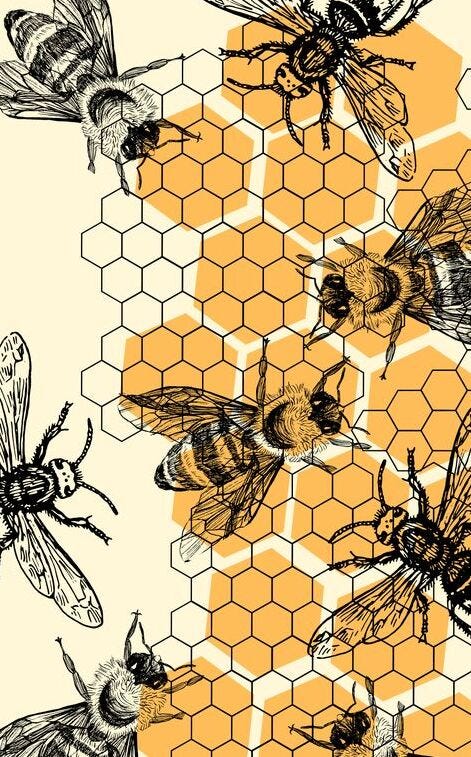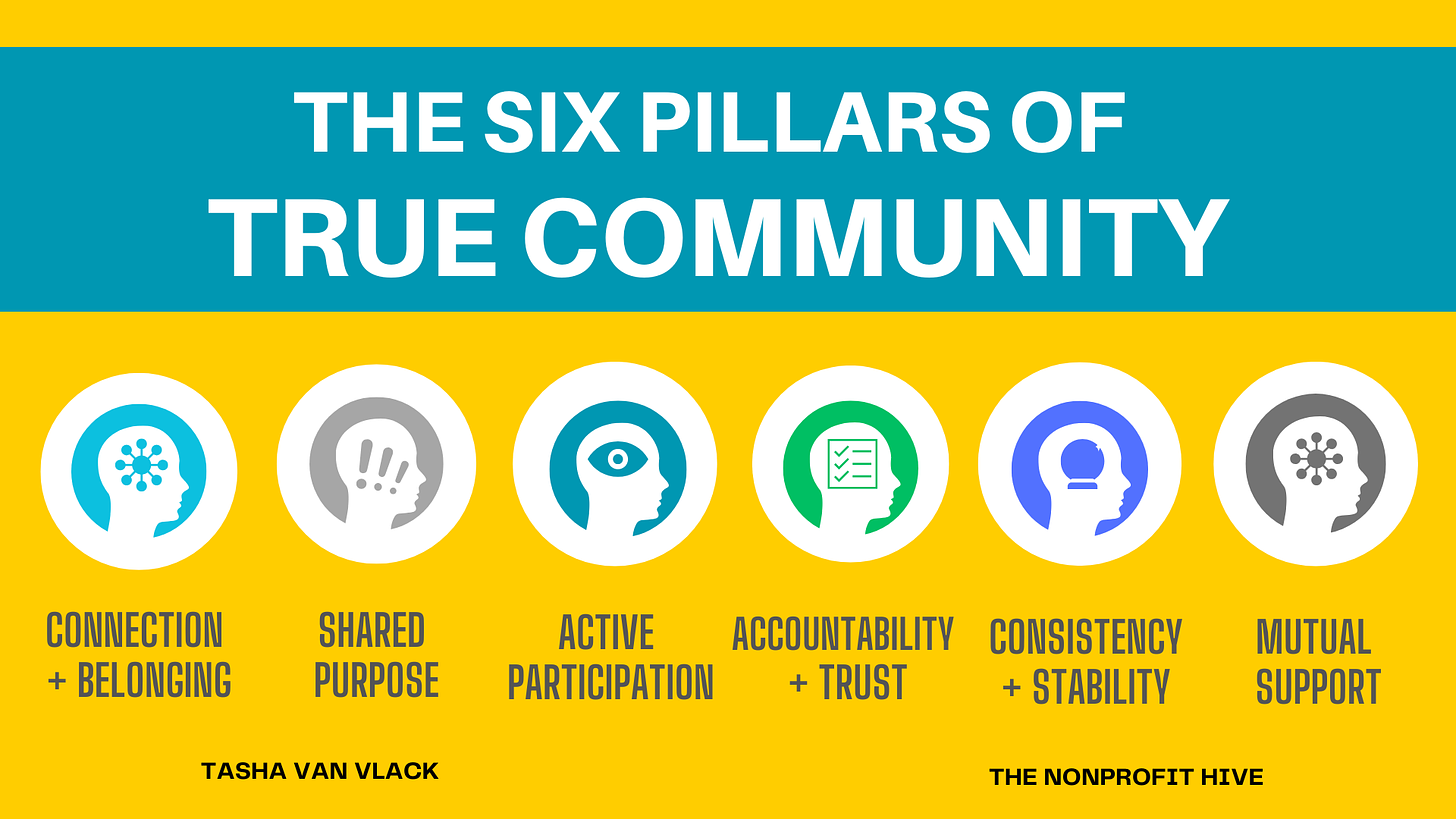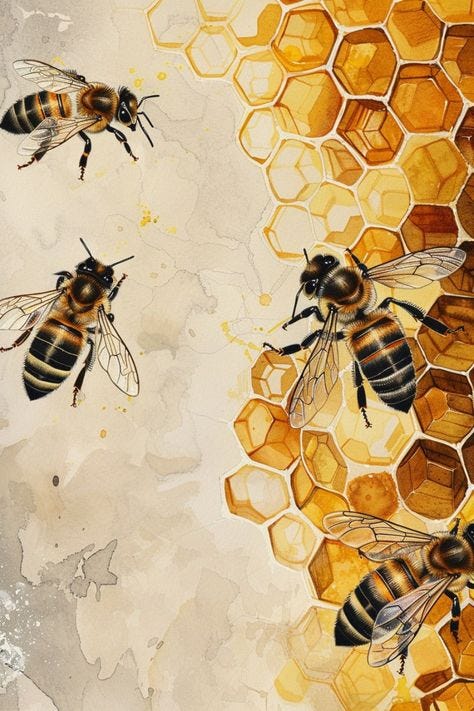Note: This is a guest article by Tasha Van Vlack of The NonProfit Hive.
“Community” used to mean something.
When our lives were rooted locally it was easy to know what someone meant when they said the word community. Back then, it wasn’t unusual to know everyone on your street, and a trip to the store meant running into familiar faces.
We HAD to leave our homes to engage with the world.
But in today’s age of social media, online ordering and instant connections, it’s easy to assume we’re more connected than ever.
The reality? Many of us are feeling disconnected.
Lately people have been asking me the “how” of building The Nonprofit Hive community. What am I doing that others might be missing? What are the pillars that make a community real, resilient, and supportive?
So here are the key components to what takes a group of people and brings them from a gathering/collective into a community.
Pillar of Community #1: The Welcome Wagon – Connection & Belonging
In the rush of constant online messaging, the feeling of true belonging often gets lost.
Belonging is that moment when people don’t just feel seen—they feel like they’re truly part of something. It’s what turns a group of strangers into a network of supporters, and it’s the foundation for any community that’s built to last.
At The Nonprofit Hive, we prioritize connection, but not in the passive way that clicking “follow” or “join” implies. Our goal is for people to feel understood and welcomed by peers who genuinely care. When members start calling themselves “Hivers” and openly share their experiences, struggles, and ideas, we know we’re building something beyond a “connection”—we’re building a community where people belong.
True belonging transforms connections into a support system where people feel comfortable enough to show up fully as themselves.
Pillar of Community #2: Mission Mojo – Shared Purpose & Values
A community built on shared purpose is like a ship with a strong rudder (or in this case I should likely use a bee+hive analogy).
Without a clear direction, a group of people may initially gather - but I have found they’re unlikely to stay. A shared purpose aligns members, giving them something to rally around—a mission, a vision, a cause.
Nonprofits can and SHOULD excel at this because purpose is woven into the very fabric of their work. Purpose gives a group its momentum, and when everyone’s in sync, that energy becomes ELECTRIC. It’s the fuel that keeps members coming back, knowing they’re here for something that matters.
At The Nonprofit Hive, we’ve built a shared commitment to reimagining nonprofit work and how social impact professionals build relationships, which fuels our conversations and brings people back time and again. When your community has a purpose that resonates, members aren’t just participating—they’re championing a cause that’s meaningful to them and making a difference.
Pillar of Community #3: All Hands In – Active Participation
Community is a verb - it truly requires ACTION.
Real community is about getting your hands dirty, and doing the work of building together.It’s easy to “like” or “share” something online, but real community involvement requires people to lean in and actively engage. Whether it’s through conversations, collaboration, or simply showing up, active participation strengthens the bonds between members.
For us at The Nonprofit Hive, active participation comes alive in our 30 minute Hive Chats. These are spaces where members don’t just passively listen; they exchange ideas, ask questions, and connect in ways that transform casual acquaintances into trusted peers.
When people actively participate, they take ownership of their community experience—and it shows. They’re more engaged, more loyal, and, ultimately, more connected to both the mission and each other.
Pillar of Community #4: Trust Falls – Trust & Accountability
Trust allows us to be our REAL-selves - and is the backbone of any thriving community.
In the nonprofit world, where passion and dedication are high, trust allows people to take risks and speak honestly. Without it, your community could end up feeling hollow…
Also, too often we rush in our community building (usually because there is some sort of profitability plan that needs to be enacted). But building trust takes TIME, especially in digital spaces.
For a community to be effective, there must be a culture of accountability—where members know they’re safe to share their perspectives and where everyone is held to a standard of respect. At The Nonprofit Hive, we build trust by maintaining transparency, creating safe spaces for members to express concerns, and consistently following through on our commitments. Trust is what allows people to take off the “professional” mask and build genuine connections, and it’s essential for any community that wants to create lasting impact.
Pillar of Community #5: The Anchor – Consistency & Stability
In today’s noisy, anxiety-inducing world, stability is an underrated pillar of community.
A strong community offers its members a sense of predictability, a place they can count on. Whether it’s a regular newsletter, a monthly gathering, or a steady stream of engaging content, consistency reassures people that they’re part of something they can rely on.
At The Nonprofit Hive, we’ve learned that even the smallest acts of consistency can create a big impact. A regular email update, familiar event formats, and even consistent language all help members feel like they’re part of something steady in an otherwise chaotic world. On LinkedIn people KNOW what we are going to talk about and what our stance/opinion is on nonprofit matters. We make it clear everyday.
This stability becomes a touchstone for members, especially during times of uncertainty, reminding them that they have a community they can lean on.
Pillar of Community #6: The Lift-Up – Mutual Support
True communities don’t just connect people.
Deep communities empower their members to support each other.
Mutual support is what makes a community resilient. In a world where many of us feel like we’re going it alone, the value of people who will show up for you—who will actually be there—cannot be overstated.
As many nonprofit professionals might have seen, we like to shout out our members over LinkedIn. I always want to be playing the game of worlds most obnoxiously enthusiastic cheerleader against others. Our members cheer each other on, share resources, offer advice, and celebrate each other’s successes.
To me, this isn’t just a “nice to have”—it’s the heartbeat of our community. We aren’t running a slack channel or mighty networks group (shocking I know!) so mutual support builds loyalty and deepens connections, turning members into advocates who care not only about their own success but about the well-being of everyone around them.
Conclusion
As a society we need to rethink what it means when we hear the word “community.”
And I think these 6 pillars—connection, purpose, participation, trust, consistency, and support—are a powerful place to start. Technology has given us new and innovative ways to connect, but the essence of community hasn’t changed.
Real community requires people who are committed to each other and to something bigger than themselves. When we focus on these pillars, we’re not just building networks; we’re creating spaces that uplift, empower, and connect us in ways that are meaningful and lasting.
For anyone looking to build or strengthen a community, it’s time to go back to basics and stop thinking that a fancy new tech is going to solve for community.
Because at the end of the day, real community is about relationships, purpose, and belonging. And that’s something technology can’t replace.
About the Author
Tasha Van Vlack is the founder and CEO at The Nonprofit Hive, a free community platform for changemakers to connect weekly and collaborate one-to-one. Tasha has been building bridges and connecting with nonprofit professionals for the last 7 years through a mixture of marketing, sales and customer success conversations. Tasha’s passion is people and you are most likely to find her in her spare time floating around LinkedIn, helping build engagement through Ember2Action or questioning the state of nonprofit with other nonprofiteers.










